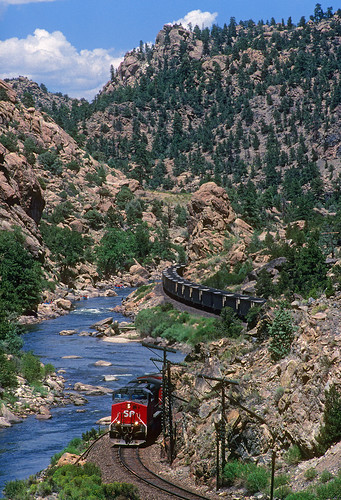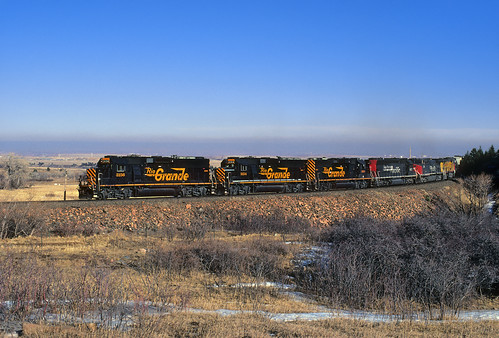The Race to Uncle Dick Wooten's Ranch
by Steve Walden, EditorIn the old west, possession really was nine-tenths of the law.
 |
| William Strong, AT&SF |
Palmer's original plan for reaching El Paso and eventually Mexico City actually went through the Santa Fe's namesake city, reaching the San Luis Valley by La Veta Pass and then south along the Rio Grande, through Santa Fe along the river all the way to the border town of El Paso, on the western tip of Texas. Yet, as the Rio Grande progressed southward through Colorado Springs and Pueblo, and finally to Walsenburg and La Veta, the appeal of Raton Pass, sitting just south of the Colorado-New Mexico border, was in vital competition with the call of the San Juan mountains in southwest Colorado and the mining revenue that the Rio Grande could lay hold of exclusively. The merchants of old Santa Fe were anxious for a railroad to make their goods accessible by a means far more efficient than the mountain route of the Santa Fe Trail that had served the city since the 1820s.
The Santa Fe Trail was a torturous affair, a crossing of the desert southwest, roamed by settlers, bandits, trappers, miners, explorers and bands of Native American warriors. Worst of all, Raton Pass--the highest point--was an axle-breaking collection of hairpin turns and conestoga-crushing overhangs. In 1865, the same year that saw both the end of the Civil War and the beginning of the westward migration of thousands of veterans and their families,an enterprising man named Richens Lacy "Uncle Dick" Wooton gathered a troop of Mexican laborers and commenced building a toll road over Raton Pass that greatly eased the travel for passengers and commerce. Over 5,000 wagons used his road in 1866, and one three month period saw Wooton collect $9,164. In terms of purchasing power, that would equate roughly to $127,000 today, a tidy sum for any entrepreneur to gross in a quarter, and a very compelling reason for the Santa Fe Railway to close in on its goal, Santa Fe, New Mexico territory.
His visit to Palmer only a recent memory, Strong had the authorization from Nickerson on February 26, 1878, to move the railroad forward. He immediately contacted A.A. Robinson, his chief engineer, with orders to get some men and lay claim to Raton Pass. Robert Athearn, in his chronicle of the Rio Grande, Rebel of the Rockies, describes what happened:
Robinson promptly boarded a Rio Grande train at Pueblo and headed for El Moro, where, late at night, he got a horse and pushed on to the home of "Uncle Dick" Wooton near the Pass. James A. McMurtrie, chief engineer for the Rio Grande, was on the same train and carried the same instructions, but unlike Robinson, he stayed overnight at El Moro, unaware of the urgency of the situation. When on the morning of February 29, McMurtrie and his men arrived at the scene of his proposed endeavors, he was greeted by Robinson and a group of transients pressed into service, all busily engaged in what they said was railroad building. The little "armies"...about equal in strength, eyed each other for a while, and after some exchange of threats, the Rio Grande men moved and began work on an alternative but much less desirable crossing at Chicken Creek. McMurtrie had lost the game by about thirty minutes. To clinch it's title to the ground, the Atchison Company asked for, and received, an injunction prohibiting its rival from interfering with construction.While the date of February 29th is suspect (1878 was not a leap year), the railway purchased the pass crossing from Wooton nonetheless that year. Joseph J. Gallager, Cultural Geographer and author of the Urbana Group's report to the National Park Service's National Register of Historic Places, wrote a fitting conclusion about the Santa Fe on the Santa Fe Trail.
... Since the Atchison, Topeka & Santa Fe Railroad had won the race for the right of way through Raton Pass, it was their trains that were to Thunder into Las Vegas (New Mexico) on July 4, 1879, and eventually into Santa Fe on February 9, 1880. Soon after this date, wagon use of the trail as a means of long distance transportation of goods and individuals proved inefficient, thus closing this chapter in history of the Santa Fe Trail.All was not completely settled, however. The Atchison, Topeka & Santa Fe Railroad was over-committed and would soon become the Atchison, Topeka & Santa Fe Railway under financial restructuring. It would proceed from New Mexico on to the Pacific coast, though not altogether unchallenged by the Rio Grande and other railroads with which it was destined to come in conflict. The race to Raton had set the stage for the Royal Gorge War, one of the most famous civil conflicts in Colorado.
While on the topic of names, the Railway portion of the name Atchison, Topeka & Santa Fe Railway picked up in said restructuring has outlasted the "AT&" of the AT&SF to BNSF Railway as its direct descendant. BNSF became the west's largest rail ..way or railroad in 1995 when Burlington Northern Railroad and AT&SF merged to become Burlington Northern Santa Fe Railway and then simply BNSF. It remains the owner of the rails of the original route over Raton Pass, which Amtrak finds to be intolerable under current maintenance standards. Amtrak has dropped more than enough hints that it plans to move its Southwest Chief away from its traditional route if maintenance standards aren't improved to keep travel times down. BNSF is not willing to increase maintenance on what it sees as a former main line, no longer a major contributor to its bottom line. The Colorado Rail Passenger Association has been driving hard to preserve the Southwest Chief on its original route. Consider joining ColoRail and adding your voice to preserve a vital link to Colorado and nearly 200 years of western history.◊
















